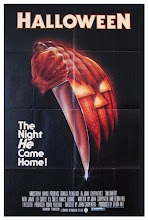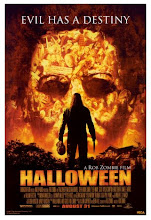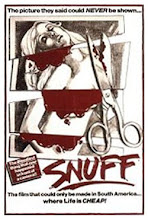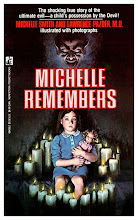To contextualize the subject properly, we first need to examine the time period that bred concerns of Satanic Ritual Abuse. With the close of the 1970s, Americans heralded in a new decade fraught with anxiety: The Vietnam War, Kent State, Watergate, Love Canal, the Jonestown Massacre, Three-Mile Island and the Iran Hostage Situation punctuated the dramatic rise in unemployment numbers, crime rates, and gas prices. No one knew what the 1980s would bring us, but many were expecting the worst, and little or nothing would surprise them.
The first year of the new decade saw the publication of a bestselling “auto-biography” which introduced the idea of Satanic Ritual Abuse. The book, Michelle Remembers, was supposedly a first-person account written by Michelle Smith (née Proby) and co-authored by her psychologist husband Dr. Lawrence Pazder. In it, the author recounted in explicit detail horrific tales of being ritually abused as a young child by Church of Satan members, her own mother included, in Vancouver, B.C. These serious allegations were the result of “recovered” memories, supposedly buried for over twenty years, and brought out by her soon-to-be husband through hypnosis.
Unfortunately for Mrs. Smith, nobody could corroborate her incredible claims, including family members, neighbors, and others with whom she grew up. Most of the thousand-odd cultists who were supposedly involved in the abuse, she claimed, were marked by a missing middle finger on their left hand, yet not one person could be found fitting this description. Furthermore, Nicholas P. Spanos, professor of psychology at Carleton University, Ottawa, Ontario, Canada, has stated that--concerning Smith’s recollections--"skepticism appears warranted by the fact that some of these ‘memories’ involve Michelle's encounters with supernatural beings." (Spanos, 269)
Shortly after Michelle Remembers saw print, the authors were threatened with a lawsuit filed by Anton LaVey, founder of the Church of Satan, for their libelous assertions against his legal and very public organization. (The Church was not founded until eleven years after the events allegedly took place, a fact which had apparently eluded Michelle and her husband.) The publisher quickly removed all references to the Church of Satan in subsequent editions of the book, and the lawsuit was dropped. (de Young, 24)
Despite the fact that Michelle Remembers was soon discredited on all fronts, its impressive sales and promotion prompted a flurry of similar cases cited by the media, most of which adhered to the formula whilst taking the bizarre claims of depravation to new lows. Patients across the country were urged by their therapists or social workers to go public with their own stories, contributing to the escalating media frenzy. Satanic ritual abuse had become a nationwide phenomenon.
Tensions mounted throughout the 1980s, and it was not long before reports of alleged Satanic Ritual Abuse were being filed in courts across the country. Accusations that began in 1983 eventually led to the highly-publicized McMartin Preschool Trial in 1987, which helped to perpetuate the fears that played upon every parent’s worst nightmare. One of the most costly criminal trials of its time, all charges were dropped and the case was officially closed in 1990 due to insufficient evidence. (Norton)
New books chronicling such alleged atrocities flew off the shelves, bearing such sensational titles as Breaking the Circle of Satanic Ritual Abuse, Don’t Make Me Go Back, Mommy, Lessons in Evil, Lessons from the Light, Released from Bondage, Satan’s Children, Satan’s Underground and Suffer the Child. These are only a few examples of the books devoted to exposing SRA published in the wake of Michelle Remembers, but all of them share one thing in common: No evidence has been found to support any of the cases reported therein. In the midst of this bizarre epidemic, even some Christians questioned the validity of these outrageous claims. In an issue of the Christian Research Journal, Bob and Gretchen Passaintino wrote, “When dozens of stories turned into hundreds and then thousands of stories, none of which produced a single piece of corroborative evidence, even some former believers became healthy skeptics.” (Passaintino, 20)
Many people assumed that the sheer number of cases alone was enough to lend the extraordinary claims credibility, no matter how outrageous or unthinkable the acts they detailed were. Editor Tamara Roleff writes:
…some therapists, law enforcement, and judicial officials theorized that an extremely organized secret network of Satanists was responsible for the violence. They estimated that Satanists were performing—and getting away with—as many as 50,000 ritual murders every year. Furthermore, they claimed, leaders of the conspiracy were noted members of the community—government and law enforcement officials, lawyers, and doctors. Because of their importance in the community, these leaders were able to keep their Satanic activities secret. (Roleff, 7)
Alleged SRA survivor Gordon Magill laments that “Satanic ritual abuse is a serious problem in the United States; however, the victims’ claims of SRA are dismissed by many as hoaxes of a form of mass hysteria. Those who advocate the ‘mass hysteria’ theory refuse to accept firsthand accounts of abuse by the children or adults who were victimized because they claim their memories are unreliable.” He then insists that “Satanic ritual abuse has many similarities to organized crime and it must be investigated in much the same way.” (Magill, 19)
A behavioral scientist at Quantico since 1981, Kenneth Lanning—regarded as an expert in cult-related criminal activity due to his work for the FBI—has since been an advisor on more than 300 investigations involving suspected cases of SRA. In a 1991 interview, he admitted that he was inclined to believe the claims early on, but “then the cases began piling up. There were lots of reports of cults, but no bodies…airplanes with heat-seeking equipment sought out mass graves on the theory that decomposing bodies would give off heat. No bodies were found. (He) stopped believing.” (Johnson, A1)
After equating SRA with alleged alien abduction accounts, Pulitzer Prize-winning scientist and bestselling author Carl Sagan examines the specifics of the SRA epidemic in his 1996 book The Demon-Haunted World: Science as a Candle in the Dark. Sagan states:
In a survey of 2,700 members of the American Psychological Association, 12 percent replied that they had treated cases of Satanic ritual abuse (while 30 percent reported cases of abuse in the name of religion). Something like 10,000 cases are reported annually in the United States in recent years. A significant number of those touting the peril of rampant Satanism in America, including law enforcement officers who organize seminars on the subject, turn out to be Christian fundamentalists; their sects explicitly require a literal devil to be meddling in everyday human life. (Sagan, 159)
The witch hunt continues to this very day, as does the argument surrounding the existence of Satanic ritual abuse. Through nothing more than “association,” The Church of Satan and its members have been the primary scapegoats throughout the struggle. The first official group to claim Satanism as a viable alternative to orthodox religions, The Church of Satan is the most widespread and widely recognized organization of its type. (Although this organization does not publicly release membership information, an official US Army pamphlet published in 1978, Religious Requirements and Practices of Certain Selected Groups: A Handbook for Chaplains, estimated that there was somewhere in the neighborhood of ten to twenty thousand official Church of Satan members at that time.) (Roleff, 6)
Due to a myriad of preconceived notions popularized and fostered by prevailing religious beliefs, Satanism as advocated by the Church bears little if no resemblance to the myths that have been perpetuated over the last millennium. Paramount is the claims of ritual abuse and bloodletting that are allegedly an integral part of Satanic practice. In two of the eleven rules on which Satanic philosophy was founded, Anton LaVey specifically states that Satanists should under no circumstances harm children, and should not kill animals except as a necessary food source, or in self-defense. “Unlike many religions and philosophies, Satanism respects and exalts life. Children and animals are the purest expressions of that life force, and as such are held sacred and precious in the eyes of the Satanist.” (LaVey, At Issue, 24) Such tenets are a far cry from the spurious claims of sadistic devil cultists who find favor with a prince of darkness through blood rituals.
Contrary to popular belief, Satanists do not worship the devil, or any other deity; “Satan” is nothing more than a symbol of the carnal nature of humanity. In addition to being stalwart atheists, Satanists consider themselves law abiding citizens; on the rare occasion a member is discovered and proven to be involved in criminal activity, their membership is immediately revoked and all affiliation withdrawn. All applicants are interviewed and carefully screened to minimize such happenstances by ensuring that potential member first have a full grasp of the tenets and abide by them. Drugs are discouraged because they hinder the individual’s ability to rationalize clearly. The Church of Satan is usually referred to as a “cult” by its detractors, even though the organization does not fit any of the various definitions usually offered within academic circles. Members are never “recruited;” all applicants come to the Church of their own volition, and can conveniently cancel their membership and affiliation at any time. Satanism encourages education and free thought, which is the antithesis of the cult mentality. “Magic” is performed by some Satanists, but these are nothing more than personalized rituals—often psychodrama—used as form of psychological catharsis that cannot be met by other means of creative self-expression. Satanism is a philosophy that bears more resemblance to secular humanism than it does any “religion.” In short, Satanists are iconoclasts whom share a base set of values that significantly differentiates them from the majority of people who hold a more orthodox view of the world.
So why have rumors of Satanic Ritual Abuse persisted, even to this day? Why have Satanists been singled out with such maliciously vilifying stereotypes, even when everything points to the contrary? Anton LaVey sums up the contention of a Satanic conspiracy best with the last of The Nine Satanic Statements: “Satan has been the best friend the church has ever had, as he has kept it in business all these years!” (LaVey, The Satanic Bible, 25)
Works Cited
Smith, Michelle, & Pazder, Lawrence. Michelle Remembers. New York: Congdon & Lattes, 1980.
Spanos, Nicholas P. “Multiple Identities & False Memories: A Sociocognitive Perspective.” Psychological Bulletin 116.1 (July 1994): 143.
de Young, Mary. The Day Care Ritual Abuse Moral Panic. Jefferson, N.C: McFarland & Company, 2004.
Norton, Richard A. (2008). “McMartin Preschool Trial.” Wikipedia. 2008. 2 Mar. 2009
Passaintino, Bob, and Passaintino, Gretchen. “The Hard Facts about Satanic Ritual Abuse.” Christian Research Journal (Winter 1992): 20.
Roleff, Tamara L. “Introduction.” At Issue: Satanism. Ed. Tamara L. Roleff. California: Greenhaven Press, 2002.
Magill, Gordan A. “Satanic Ritual Abuse Is a Problem.” At Issue: Satanism. Ed. Tamara L. Roleff. California: Greenhaven Press, 2002.
Johnson, John, and Padilla, Steve. “Satanism: Skeptics Abound.” Los Angeles Times. 23 Apr. 1991: A1. Los Angeles Times. ProQuest. Everett Community Coll. LMC, WA. 3 Mar. 2009.
Sagan, Carl. The Demon-Haunted World: Science as a Candle in the Dark. New York: Ballantine Books, 1996.
LaVey, Anton S. “The Eleven Satanic Rules of the Earth.” 1967. 2 Mar. 2009.
LaVey, Anton S. “Church of Satan’s Advice to Youth.” At Issue: Satanism. Ed. Tamara L. Roleff. California: Greenhaven Press, 2002.
LaVey, Anton S. The Satanic Bible. New York: Avon Books, 1969.

+One-Sheet.jpg)
+One-Sheet.jpg)
+One-Sheet.jpg)

No comments:
Post a Comment